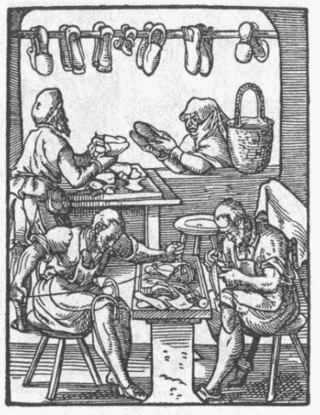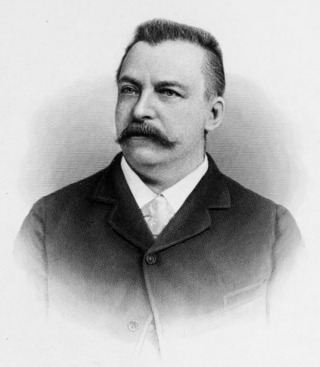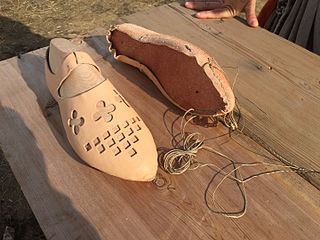
A shoe is an item of footwear intended to protect and comfort the human foot. Though the human foot can adapt to varied terrains and climate conditions, it is vulnerable, and shoes provide protection. Form was originally tied to function, but over time, shoes also became fashion items. Some shoes are worn as safety equipment, such as steel-toe boots, which are required footwear at industrial worksites.

Footwear refers to garments worn on the feet, which typically serve the purpose of protection against adversities of the environment such as wear from rough ground; stability on slippery ground; and temperature.

A climbing shoe is a specialized type of footwear designed for rock climbing. Typical climbing shoes have a tight fit, an asymmetrical downturn, and a sticky rubber sole with an extended rubber rand to the heel and the toe. Different types of shoes can be better suited for different levels of technique and routes.

Clogs are a type of footwear made in part or completely from wood. Used in many parts of the world, their forms can vary by culture, but often remained unchanged for centuries within a culture.

Sandals are an open type of shoe, consisting of a sole held to the wearer's foot by straps going over the instep and around the ankle. Sandals can also have a heel. While the distinction between sandals and other types of footwear can sometimes be blurry, the common understanding is that a sandal leaves all or most of the foot exposed.

A last is a mechanical form shaped like a human foot. It is used by shoemakers and cordwainers in the manufacture and repair of shoes. Lasts come in many styles and sizes, depending on the exact job they are designed for. Common variations include simple one-size lasts used for repairing soles and heels, custom-purpose mechanized lasts used in modern mass production, and custom-made lasts used in the making of bespoke footwear. Lasts are made of firm materials—hardwoods, cast iron, and high-density plastics—to withstand contact with wetted leather and the strong forces involved in reshaping it. Since the early 19th century, lasts typically come in pairs to match the separate shapes of the right and left feet. The development of an automated lasting machine by the Surinamese-American Jan Ernst Matzeliger in the 1880s was a major development in shoe production, immediately improving quality, halving prices, and eliminating the previous putting-out systems surrounding shoemaking centers.

Shoemaking is the process of making footwear.

Combat boots are military boots designed to be worn by soldiers during combat or combat training, as opposed to during parades and other ceremonial duties. Modern combat boots are designed to provide a combination of grip, ankle stability, and foot protection suitable for a rugged environment. They are traditionally made of hardened and sometimes waterproofed leather. Today, many combat boots incorporate technologies originating in civilian hiking boots, such as Gore-Tex nylon side panels, which improve ventilation and comfort. They are also often specialized for certain climates and conditions, such as jungle boots, desert boots, and cold weather boots as well as specific uses, such as tanker boots and jump boots.
Jungle boots are a type of combat boot designed for use in jungle warfare or in hot, wet, and humid environments where a standard leather combat boot would be uncomfortable or unsuitable to wear. Jungle boots have vent holes in the instep and sometimes a canvas upper to aid in ventilation and drainage of moisture.

Jump boots are a type of combat boot designed for paratroopers featuring calf-length lacing and rigid toe caps. The style was developed in many countries simultaneously with the adoption of airborne infantry forces during World War II. Modern jump boots are earned in some countries and therefore have become a mark of achievement and distinction, mainly worn as dress and parade boots. The uppers are generally made of smooth black leather with toe-caps and heel counters that accept a high polish. It is also a paratrooper tradition to lace jump boots in a ladder or cobweb style which increases ankle support during a parachute jump.

Hiking (walking) boots are footwear specifically designed for protecting the feet and ankles during outdoor walking activities such as hiking. They are one of the most important items of hiking gear since their quality and durability can determine a hiker's ability to walk long distances without injury. Hiking boots are constructed to provide comfort for walking considerable distances over rough terrain. Boots that protect the hiker's feet and heel are recommended. Hiking boots give ankle support and are fairly stiff. A less popular alternative is to use light trainers with thin soles. Footwear should be neither too loose nor too tight, to help prevent blisters and sore feet. Hiking socks that wick sweat from the feet, provide warmth, and cushion the feet are recommended and a thin, inner sock may also help. Most hiking boots are also designed for other outdoor activities such as backpacking, climbing, mountaineering, and hunting.

Skate shoes or skateboard shoes are a type of footwear specifically designed and manufactured for use in skateboarding. While numerous non-skaters choose to wear skate shoes as they are popular in fashion, the design of the skate shoe includes many features designed especially for use in skateboarding, including a vulcanized rubber or polyurethane sole with minimal tread pattern or no pattern, a composition leather or suede upper, and reinforced stitching to extend the life of the upper material. The most important aspect of skate shoes is that they have flat soles which allow the skater to have better board control.

Galoshes, also known by many other names, are a type of overshoe or rubber boot that is put on over shoes to keep them from getting muddy or wet during inclement weather.

A court shoe or pump is a shoe with a low-cut front, or vamp, with either a shoe buckle or a black bow as ostensible fastening. Deriving from the 17th- and 18th-century dress shoes with shoe buckles, the vamped pump shape emerged in the late 18th century. By the turn of the 19th century, shoe buckles were increasingly replaced by black bows, which has remained the contemporary style for men's formal wear, leather or patent leather evening pumps ever since. This latter style is sometimes also called an opera pump or opera slipper.

Christian Dancel was a German-American inventor. He was most notably under contract with the Goodyear Shoe Machinery Company of Connecticut.

A turnshoe is a type of leather shoe that was used during the Middle Ages. It was so named because it was put together inside out, and then was turned right-side-out once finished: this hides the main seam between the sole and vamp—prolonging the life of the shoe and inhibiting moisture leaking in through the seam.

Cleats or studs are protrusions on the sole of a shoe or on an external attachment to a shoe that provide additional traction on a soft or slippery surface. They can be conical or blade-like in shape and can be made of plastic, rubber or metal. The type worn depends on the environment of play: grass, ice, artificial turf, or other grounds.

Solovair is a brand of British-made boots and footwear, produced by NPS Shoes Ltd., which was established in 1881. The NPS factory is based in Wollaston, Northamptonshire, an area known for its shoe industry. NPS shoes are known for their Goodyear welt technology which is used in all their shoe production. This particular technique is needed to fix the Solovair sole onto "Soft Sole Suspension" boots and shoes.

In a boot or shoe, the shank is a long, thin piece of material between the insole and outsole intended to support the foot and provide structure.
FEIT is an Australian shoe and accessories brand based in New York City. Founded in 2005. Feit is owned and operated by brothers Tull and Josh Price. FEIT products are handmade using natural materials.


















